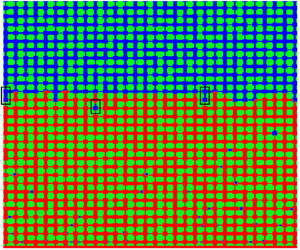Crossref Citations
This article has been cited by the following publications. This list is generated based on data provided by
Crossref.
Shi, Haidong
Zhu, Qingyuan
Chen, Zhangxin
Li, Jing
Feng, Dong
Zhang, Shengting
Ye, Jiawei
and
Wu, Keliu
2023.
Pore-scale modeling of water–gas flow in heterogeneous porous media.
Physics of Fluids,
Vol. 35,
Issue. 7,
2023.
A comprehensive mathematical model for spontaneous imbibition in oil-saturated fractured tight sandstones: Incorporating fracture distribution, displacement pressure, gravity, and buoyancy effects.
Physics of Fluids,
Vol. 35,
Issue. 6,
Peng, Xiaolong
Wang, Xiangzeng
Zhang, Yizhong
Huang, Xiaoliang
and
Zeng, Fanhua
2023.
Experimental study of strong imbibition in microcapillaries representing pore/throat characteristics of tight rocks.
Fuel,
Vol. 342,
Issue. ,
p.
127775.
Li, Bingbing
Yan, Zhenyang
Li, Changyu
Ma, Qipeng
Zhang, Shasha
and
Wang, Yungang
2023.
Pore-scale experimental investigation on the co-current spontaneous imbibition of gas–water two-phase with gravity force.
Physics of Fluids,
Vol. 35,
Issue. 11,
Zhan, Ninghua
Wang, Yiping
Lu, Xiang
Wu, Rui
and
Kharaghani, Abdolreza
2024.
Pore-corner networks unveiled: Extraction and interactions in porous media.
Physical Review Fluids,
Vol. 9,
Issue. 1,
He, Zhennan
Zhang, Yinglong
Zhao, Pei
Zhou, Yan
Xin, Gongming
and
Qin, Ning
2024.
Strong effect of often-overlooked initial spilled oil distribution on subsequent soil remediation: A pore-scale perspective.
Journal of Cleaner Production,
Vol. 478,
Issue. ,
p.
144000.
Brindt, Naaran
Min, Xinying
Yan, Jiuzhou
Jung, Sunghwan
Parlange, J-Yves
and
Steenhuis, Tammo S.
2024.
Measuring pore water velocities and dynamic contact angles at unstable wetting fronts.
Advances in Water Resources,
Vol. 186,
Issue. ,
p.
104661.
Liu, Jian
Qu, Xuefeng
Wang, Jiwei
Liu, Qiang
Zhang, Lei
Huang, Tao
and
Yu, Haiyang
2024.
Investigating the Influencing Factors of Imbibition of Fracturing Fluids in Tight Reservoirs.
Processes,
Vol. 12,
Issue. 1,
p.
236.
Jin, Yan
and
Kuznetsov, Andrey V.
2024.
Multiscale modeling and simulation of turbulent flows in porous media.
International Journal of Fluid Engineering,
Vol. 1,
Issue. 1,
Wang, Peilong
Gao, Jun
Xiao, Boqi
Long, Gongbo
Zheng, Qian
and
Shou, Dahua
2024.
The Fastest Capillary Flow in Root-like Networks under Gravity.
Langmuir,
Vol. 40,
Issue. 18,
p.
9741.
Li, Sheng
Liang, Yunfeng
Jiang, Fei
Tsuji, Takeshi
Liu, Haihu
Usui, Keishi
Taniguchi, Tomohiro
and
Jo, Gyuhwan
2024.
Multiscale simulation of water/oil displacement with dissolved CO2: Implications for geological carbon storage and CO2-enhanced oil recovery.
Chemical Engineering Journal,
Vol. 499,
Issue. ,
p.
155936.
Chen, Kexin
Liu, Pengfei
Wang, Wenyuan
Wang, Linhan
Wang, Yan
Liu, Hao
Yan, Zizhuang
Zhao, Yu
Song, Kaichen
Chen, Yunmin
and
Bate, Bate
2025.
Hypergravity experimental study on immiscible fluid–fluid displacement in micromodels.
Fuel,
Vol. 391,
Issue. ,
p.
134776.
Wang, Wenyuan.
Liu, Pengfei.
Chen, Kexin.
Chen, Yunmin.
and
Bate, Bate
2025.
Hypergravity effects on immiscible two-phase displacement processes via CFD simulation and an analytical bi-channel model.
Computers and Geotechnics,
Vol. 186,
Issue. ,
p.
107417.
Zhang, Shengting
Li, Jing
Coelho, Rodrigo C.V.
Wu, Keliu
Zhu, Qingyuan
Guo, Shiqiang
and
Chen, Zhangxin
2025.
Lattice Boltzmann modeling of forced imbibition dynamics in dual-wetted porous media.
International Journal of Multiphase Flow,
Vol. 182,
Issue. ,
p.
105035.
Zhong, Yiyan
Li, Qi
Gao, Wenbin
Wen, Yiping
and
Zhang, Yao
2025.
A review of microfluidic technology for CO2 sequestration in saline aquifers.
Journal of Rock Mechanics and Geotechnical Engineering,
Li, Sheng
Zhang, Yifan
Wang, Ningning
Wang, Zhiheng
and
Liu, Haihu
2025.
Pore-Scale Investigation of Water-Alternating-Gas Injection for CCUS in Water-Wet Porous Media.
Energy & Fuels,
Vol. 39,
Issue. 6,
p.
3039.

 $\varepsilon$), we show that the application condition of the quasi-3D method is
$\varepsilon$), we show that the application condition of the quasi-3D method is  $\varepsilon \leqslant 1/3$. Next, we simulate spontaneous imbibition in micromodels with various geometries and flow conditions. Fingering and compact displacement are identified for varying viscosity ratios and gravitational accelerations. At low (high) viscosity ratio of wetting to non-wetting fluids, an upward (downward) gravity can promote the stability of the wetting front, favouring the transition from fingering to compact displacement. In addition, we find that the depth-oriented interface curvature dominates the capillary effect during the imbibition, and such a mechanism is considered by introducing an equivalent contact angle into the theoretical model. With the help of equivalent width and contact angle, the theoretical model is shown to provide satisfactory prediction of the compact displacement process. Finally, a micromodel experiment is presented to further verify the developed theoretical model and the quasi-3D simulation.
$\varepsilon \leqslant 1/3$. Next, we simulate spontaneous imbibition in micromodels with various geometries and flow conditions. Fingering and compact displacement are identified for varying viscosity ratios and gravitational accelerations. At low (high) viscosity ratio of wetting to non-wetting fluids, an upward (downward) gravity can promote the stability of the wetting front, favouring the transition from fingering to compact displacement. In addition, we find that the depth-oriented interface curvature dominates the capillary effect during the imbibition, and such a mechanism is considered by introducing an equivalent contact angle into the theoretical model. With the help of equivalent width and contact angle, the theoretical model is shown to provide satisfactory prediction of the compact displacement process. Finally, a micromodel experiment is presented to further verify the developed theoretical model and the quasi-3D simulation.